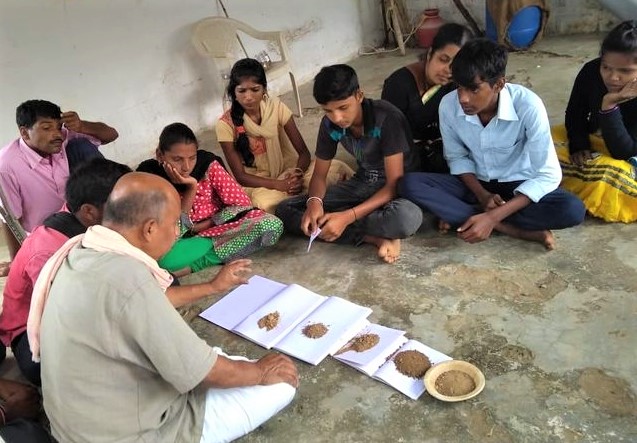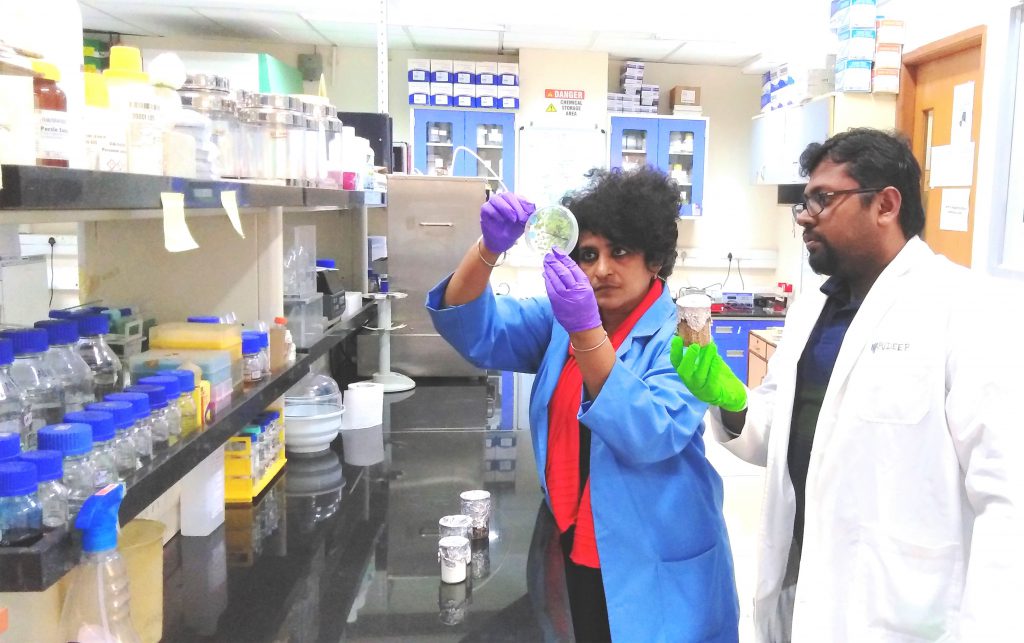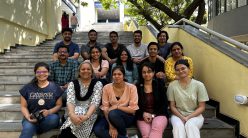The soil under our feet is teeming with life, and understanding and nurturing it has a positive impact on our lives

green after the rains (Photo: Narmada Khare)
A memory.
My friend and I followed the ball as it bounced towards the pit in the backyard. Heat wafted up, and the air was saturated with a warm, earthy smell that wasn’t totally unpleasant. We had explicit instructions to not step into this pit, so we stood at the edge and mourned the ball that had fallen in.
“It’s a compost pit,” my friend explained. Theirs was a farming family, and the backyard housed some cows and chicken, and a lily pond. A gardener swept the yard every morning, and dumped the dry leaves and the dirt from the chicken coop into the pit. The kitchen waste and cow dung also went in there. “You can’t see them,” my friend continued, “but there are tiny creatures there that turn all that waste into soil.”
I was seven years old, and that was my first introduction to the creation of rich, nourishing, productive soil.
Over the years, I noticed other aspects of soil. The moist, spongy forest soil smelled the same as that pit did long ago, particularly after warm rains. The soil in Nagpur was black, and that in Bangalore was red. Silt from the Himalayas made the Ganga seem slate-grey in Rishikesh, and the Rann of Kutch was shiny white with salty, sandy soil. In short, soil wasn’t just dirt. It had personality. I began to think of soil as a quilt that covered the Earth.
A leaf spread across the desert
Trent Northen, a scientist at the Lawrence Berkeley National Laboratory in the US, has a different way of looking at soil. He is more interested in the life thriving inside the ‘biological soil crusts’ that cover almost 70% of the desert landscape of the Colorado Plateau. These crusty sheets are teeming with microbes, living off the precious desert moisture trapped in the upper soil matrix. Many of them are species of Cyanobacteria, mistakenly called blue-green algae. In his 2013 Science at the Theatre talk, Northen says, “They are not plants. They are photosynthetic microbes. And they have productivity, as if you’ve spread a leaf across the whole desert!”
The dry and semi-dry lands across the world are covered with these living, breathing crusts. If you step off the beaten path, you are bound to tread upon them. They save the topsoil from being eroded by wind or rain. They trap nitrogen and carbon from the air, and make them available for other life-forms in the soil, including plants. And as for cyanobacteria, no book
about the early days of our planet is complete without the humbling tale of how they made Earth’s atmosphere ‘breathable’ for life.
The surface of the Earth has been the stage for an ongoing drama for some 4.5 billion years. The mellow planet we live on today, once raged under extreme temperatures, pressure, and humidity. The atmosphere of the young Earth had little to no free oxygen. It was all tied up as water (H2O), carbon dioxide (CO2) and other oxides. The single-celled cyanobacteria appeared on the scene about 3.5 billion years ago. They evolved a mechanism we now call photosynthesis, and began the production of carbohydrates – the chemicals that store energy – and oxygen. As their numbers increased, so did the proportion of free oxygen in the air.
Geoscientists believe that originally, the land was made of bare rock. Over time, with increase in oxygen, organic life began to thrive. Fossil records suggest that photosynthetic unicellular life paved the way for more complex algae and fungi, and later, larger flora with roots. Each generation died, decomposed, and filled the crevices of rocks to form a nutrient-rich bed of soil for the next.
Soil – a mixture of crushed rock, decaying organic matter and microbes – is an integral part of human life. Our history records civilisations that were lost because they were buried under volcanic ash, or because the land around them became infertile as the salinity in the soil increased. Our languages are replete with glorious imagery about soil: Ideas are said to ‘take root in the fertile soils’ of young minds, great leaders were often called ‘sons of the soil’, many of our once great cities are today just ‘another layer on top of the soil’, and finally, ‘we go from ashes to ashes, and from dust to dust’. Most of us are aware of our connection to soil, but for some people, their lives are more deeply intertwined with it. P Srinivas, known to the farmers of Karnataka as “Soil Vasu”, is one of those people.
Compost, cattle and microscopes

In 1984, when Vasu started working with farmers in Anekal, a town outside Bangalore, his goal was to educate them and document their culture. But as he spent more time with them, he began to notice certain things that made him aware of their hardships. “I used to be talking to them, and they would be laughing,” he recalls. “But their eyes were not laughing.” There was pain there that he did not understand then, he adds.
Working with the Institute for Cultural Research and Action (ICRA) in Bangalore, Vasu began to focus on agriculture. He educated himself about farming through books and training sessions offered by the Institute. He had already noticed some obvious problems with the agricultural practices in the area. “Crops were failing, soil was eroding.” Instead of replenishing the topsoil, “they were adding more chemicals,” Vasu says. Soon, the more thoughtful among the farmers in Karnataka as well as other states began searching for alternatives to chemical-based farming, and Vasu invited several of them to talk to the farmers he worked with. He translated informative books from English to Kannada, filling a major knowledge gap. In simple, musical Kannada, he explained to the farmers how they could understand their soil better.
Vasu has designed and conducted intensive two-day-long demonstration and training sessions for farmers. He asks them to bring the soil from their fields, and shows them ways to assess its quality. Based on the proportion of sand, silt, clay and organic matter, the farmer can then choose the appropriate crop to plant.
Together with Prabhakar Buddappa, whom he describes as his guru and ‘geleya’ (friend, in Kannada), Vasu tries to explain the importance of soil biodiversity to the farmers. He explains that Prabhakar is a traditional farmer from Thondahalli village in Kolar district, Karnataka, and understands the hurdles in talking to the farmers about microorganisms. While they have seen the results of composting, few are aware that it is the process of decomposition of organic matter by microbes, and that the majority of microbes come from soil and dung of farm animals. How can one explain soil life when most of it cannot be seen by the eye? Although Vasu carries magnifying glasses with him on his training sessions, he acutely feels the need for equipment like microscopes.
How can one explain soil life when most of it cannot be seen by the eye?
“I want every farmer to have compost, cattle, and a microscope,” he muses. “See, when a farmer starts looking at his own soil, his own water, then he asks, ‘what is there in this soil? Last time, I applied this [chemical fertiliser]; has the soil life improved? Is there diversity of microbes? Oooh, it is not there!’ Then he works on his soil. When he realises that chemicals are killing soil life, then he stops using them and starts using organic material. A kind of enthusiasm develops.”
Vasu’s enthusiasm is infectious. This is how he explains how one can ‘read’ one’s land: “After the first rain, before ploughing, spread 20-30 types of sowing seeds (mixing them well before spreading) and then plough. After 30-40 days, they germinate and develop as tender plants. Observe which plants have come up well. Make a list of the best 10-15 crops. The soil is telling us that it can grow these plants better. This is considered as understanding the language of the soil. After making the list, now plough over all the saplings and bury them back in the soil. This improves its structure.”
Vasu’s efforts draw attention to the fact that farmers’ concerns are a socio-scientific challenge. Educating them, making information available, convincing them to refrain from using chemicals and helping them through the transition to organic farming, is just one part of the solution. Several organisations like ICRA and people like Vasu are making inroads there. But the other aspect is that of understanding the biological issues related to soil, such as contamination from pathogenic microbes, the depletion of protective-chemical-producing fungi due to some reduced nutrients, and so on. These may not be obvious to the farmers, and so, are harder to address. That is where scientists like those at IISc step in.
In the early years of IISc, a lot of biochemical research was geared toward solving practical problems faced in farming. Analysing essential elements like nitrogen and carbon in soil, making them available to the crop by using bacteria that fixed them, treating sewage to make it amenable to microbes and unicellular organisms, and then using it as fertiliser, are just some of the many examples of projects that have been described in the IISc Annual Reports from the first five decades of the Institute. Later, with the advent of molecular biology, the focus of the researchers moved to more fundamental problems in biology.
One of the scientists whose interests still lie in soil and its relationship to agriculture is Dipshikha Chakravortty, Professor at the Department of Microbiology and Cell Biology.

a model farm planted with a variety of seeds (Photo courtesy: P Srinivas)
A consortium of bacteria, fungi and viruses
Dipshikha has worked with Salmonella, a pathogenic bacterium, for many years. In 2014, when Kapudeep Karmakar, a student with a Master’s degree in agriculture, joined her lab for a PhD, her interests turned to the impact of this microbe on farming. A paper had appeared in the Morbidity and Mortality Weekly Report (MMWR), published by the US Centres for Disease Control and Prevention. It discussed an outbreak of Salmonella, which had infected people via fruits and vegetables sourced from farms. The cause for the outbreak was thought to be ‘post-harvest,’ meaning the infection had originated from the handlers, rather than from the crop itself. Many California tomato farms had to shut down, and in other parts of the world, the chocolate industry was in trouble.
“We did not believe that such a massive outbreak could be caused by post-harvest handling,” remembers Dipshikha. “Kapudeep came from Asansol in West Bengal, and knew that belt is quite heavy on Salmonella in the soil.” They suspected that in California too soil contamination must be the real culprit.
But even if the soil were contaminated with Salmonella, the bacteria could not enter and infect a plant unless there was a breach in the plant tissue. After careful experimentation on the plant model Arabidopsis, as well as tomato plants, the researchers found that such a breach develops when the primary root sends out lateral roots. A natural wound develops in the plant tissue at this site, and Salmonella enter and infect the plant through it.
Dipshikha points out that microbes like Salmonella face enormous competition for survival. “Soil is a consortium of many billions of bacteria, fungi and viruses.” She explains that many of these cannot even be cultured in a lab. This biodiversity in the soil keeps harmful bacteria in check. “Salmonella may even be killed by some soil bacteria. Kapudeep recently showed that Lysinibacillus is a bacterium in the soil that can kill Salmonella – like a biocontrol.”
Dipshikha’s team is also developing a sensor for farmers to detect even small concentrations of Salmonella in their soil. “It [the sensor] must be cheap and [work] rapidly – like a chip that will give a reading quickly, so that the farmer can prepare to control the outbreak.”
And what can be done after the soil is contaminated? Dipshikha has several suggestions, starting from barricading the area completely.
“You cannot use that piece of land till some biocontrol comes.” There can be human intervention, but Dipshikha believes that there are bound to be other soil microbiota that could outcompete Salmonella. She also suggests using beetroot as a ‘trapper’. The beetroot plant secretes the pigment ‘betalain’ into the surrounding soil, and Salmonella are susceptible to it. She suggests planting beetroot around tomato plants as a co-culture. “The size of the beetroot is very small, because it gets infected with Salmonella and [at the same time] goes on producing [more and more] betalain. So, you cannot harvest the beetroot, but your tomatoes will be hale and hearty,” she laughs.

(Photo courtesy: Kapudeep Karmakar)
People like Dipshikha and Vasu may be looking at the same problem from different angles but they are united by a common purpose – understanding soil health and its impact on our lives. In a country that is among the largest crop producing nations in the world, there are several children of the soil, toiling away, above and below ground, whose lives are both shaping and being shaped by soil. Vasu says, “Know soil, know life.” Or does he mean, “No soil, no life?”




